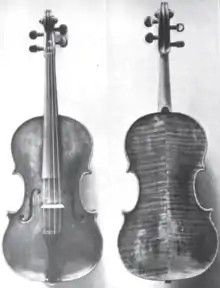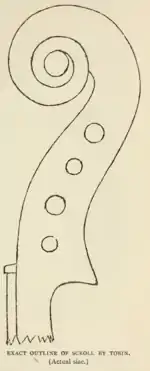Richard Tobin (luthier)
Richard Tobin (Irish: Risteárd Tóibín; 1766 – December 1847) was an Irish luthier and maker of violins, violas, cellos and pochettes.[2] Tobin's work was largely uncredited, often branded under the names of his employers and other shops that enlisted him for his sought-after workmanship.[1] As a luthier, he has been described as "a genius".[3] As well as being known for the quality of his instruments, Tobin is famous for the workmanship of his scrolls, of which it has been said "never did Antonio Stradivari cut better".[4]
Richard Tobin | |
|---|---|
Risteárd Tóibín | |
 Violin by Tobin, published in 1920[1] | |
| Born | 1766 Dublin, Ireland |
| Died | December 1847 (aged 80–81) Middlesex, London |
| Nationality | Irish |
| Education | Thomas Perry |
| Known for | |
| Notable work |
|
| Style |
|
| Movement |
|
| Spouse | Elizabeth Daley |
| Children |
|
| Parent | Richard Tobin (father) |
Early life
Tobin was born near Dublin around 1766.[5][6] Musicologist Brian Boydell suggested that he was probably born in Waterford, possibly because of the connection with some of his earlier instruments.[5] However, luthier and historian Rev. William Meredith Morris states that "according to his own account he [Tobin] was born a few miles out of Dublin".[7] The year in which Tobin was born has also been debated, with estimates varying from as early as 1760 to as late as 1777.[8][9] Burial and workhouse records from the UK National Archives confirm that Tobin was born in 1766.[10]
Tobin is said to have developed a love for the violin in early childhood from hearing it being played at parties and wakes.[11] He started making violins as a young boy out of boxes and scrap wood.[12] Rev. Morris describes how at the age of fourteen, Tobin made a fairly good instrument out of a willow block and sold it to a neighbouring fiddle player. The neighbour is said to have brought the instrument to the attention of renowned Dublin luthier, Thomas Perry, who was so impressed with its workmanship that he decided to take Tobin on as his apprentice.[12]
It is not known who Tobin's parents were, or where they were from. A violin from Tobin's time at the Perry firm inscribed 'Richard Tobin Junior' suggests that he may have been named after his father.[13] However, it is possible that Tobin appended 'Junior' to his name to indicate that he was an apprentice at the time.
Career
Apprenticeship and early career: 1783–1810
Tobin apprenticed with the renowned Dublin luthier Thomas Perry around 1783–1790.[9] One instrument bearing his label gives Waterford as his residence in 1800. Tobin is believed to have worked briefly for Bartholomew Murphy of Cork shortly afterwards and is listed at Patrick St., Cork in 1805.[14] He then worked independently before moving to London on the advice of Vincenzo Panormo, who had earlier worked for Perry.
London and later career: 1810–1847
Tobin's earliest London work is dated 1810 and appears to have been made under the aegis of Henry Lockey Hill. A violin dated 1817 is signed ‘R. Tobin for L. Hill’ internally. He was established in St Leonard Street, Finsbury Square, and from 1823 in his own premises at 9 West Street, Soho.[15][16] Tobin's son, George, was apprenticed to him around 1823–1830 and was an active violin maker around 1830–1840, but has mistakenly been recorded as "James Tobin" by historians.[17][18] Like his father, George's work is very rarely identified and generally unlabelled, and he is thought to have worked exclusively for other violin makers and dealers.[18]
Style and technique

Richard Tobin's workmanship is considered accurate and finely finished in classical Italian styles. The few instruments which bear his label are typically copies of Amati or Stradivari violins, and they are said to have a rich and mellow tone. The varnish on Tobin violins varies considerably as he often supplied shops with unvarnished instruments or used the varnish provided by the shop he was working in at the time.[19]
Tobin is regarded as one of the greatest ever scroll carvers, and his hand can be recognized on many instruments with the shop label of John Betts, Thomas Dodd, Samuel Gilkes and Henry Lockey Hill. Such was the quality of his scrolls that an outline of one was included in Rev. Morris' 1904 book British Violin Makers.[7] Despite his meticulous workmanship, he is said to have worked very fast, and apparently could finish a scroll inside of two hours.[4] Some of his instruments were signed internally on the table and occasionally branded below the back button, although authentic Tobin labels are extremely rare.
| |||||||||||||||||||||||||||||||||||||||||||||||||||||||||||||||||||||||||||||||||||||||||||||||||||||||||||||||||||||||||||||||||||||||||||||||||||||||||||||||||||||||||||||||||||||||||||||||||||||||||||||||||||||||||||||||||||||||||||||||||||||||||||||||||||||||||||||||||||||||||||||||||||||||||||||||||||||||||||||||||||||||||||||||||||||||||||||||||||||||||||||||||||||||||||||||||||||||||||||||||||||||||||||||||||||||||||||||||||||||||||||||||||||||||||||||||||||||||||||||||||||||||||||||||||||||||||||
| |||||||||||||||||||||||||||||||||||||||||||||||||||||||||||||||||||||||||||||||||||||||||||||||||||||||||||||||||||||||||||||||||||||||||||||||||||||||||||||||||||||||||||||||||||||||||||||||||||||||||||||||||||||||||||||||||||||||||||||||||||||||||||||||||||||||||||||||||||||||||||||||||||||||||||||||||||||||||||||||||||||||||||||||||||||||||||||||||||||||||||||||||||||||||||||||||||||||||||||||||||||||||||||||||||||||||||||||||||||||||||||||||||||||||||||||||||||||||||||||||||||||||||||||||||||||||||||
Personal life
Tobin married an Irish woman named Elizabeth Daley (born c. 1777) in Cork around the time he was working for Bartholomew Murphy. They had at least 4 children, George (born c. 1809 in Cork), John (born 6 Dec 1811 in London) Elizabeth (born 18 January 1815 in London) and Esther (born c. 1838 in London). On 8 Dec 1816, Tobin baptised two of his children, John and Elizabeth, in St Leonard's, Shoreditch and the family is recorded as living at Leonard Street in Shoreditch. On 24 May 1818, Tobin's younger son, John, died at only 6 years of age. By 1841, Tobin was living with his wife and two daughters at 65 New Compton Street in St Giles, London, according to the UK Census.[20] He is recorded as being aged 70, suggesting that he was born 1771.[20] However, it is likely that his age was estimated incorrectly by another individual in his absence.
The parish of St Giles where they lived had a reputation for poverty and some of the worst living conditions in London at the time. It is possible that Tobin ended up in that part of London because of his connection to Panormo, who had also settled there with his two youngest sons.[21] Panormo's son, Louis, later set up his shop in the area, as did French luthier, Georges Chanot III. To this day, the surrounding area of Soho in London is known for its violin makers and sellers, including Tarisio, J & A Beare, Ingles & Hayday, Bishop Instruments & Bows and Stringers of London.
Tobin was thought to be eccentric and intemperate, often trying the temper of his employers. He was known to go through extended periods of heavy drinking, until all his savings were spent after which he would remain sober for several months until he had saved up enough money again. He failed to sustain himself as a luthier in later life, ending up in Shoreditch poorhouse in 1845. He died in early December, 1847 and was buried in a pauper's grave in St Leonard's, Shoreditch on 7 December 1847.[22]
Extant instruments
It is unknown how many instruments Tobin produced in his lifetime. Some of them still survive today and occasionally come up for sale or auction, others are housed as part of collections or exhibits. However, many more are likely uncredited or branded under the names of his employers or their shops. One of his violins, made in London c. 1820, is now part of The Harrison-Frank Family Foundation collection and is currently on loan to violinist Emma Pantel.[23] One of Tobin's cellos, currently played by Thomas Mesa, was used to record soundtracks for the first movies ever created.[24] One of his pochettes (also known as a kit or dance master's fiddle) is currently housed in the National Music Museum, Vermillion, South Dakota.[25]
Some of Tobin's notable instruments:
Violins
- 1789: Dublin, Labelled 'Made by Thos. Perry, 6 Anglesea Street, Dublin, No. 533, 1789', inscribed internally 'Richard Tobin Junior' on the inner table and inner bottom rib.[26]
- c. 1800 (No. 407): Waterford, Labelled 'Made by Richard Tobin, Mus. Instr. Maker, Waterford'[5]
- c. 1805: Cork, branded externally 'TOBIN/CORK' beneath the button.[27]
- 1810: London, unlabelled (Cozio 104007).[28]
- c. 1820: London, unlabelled (Cozio 104008).[29]
- c. 1820: London, The Harrison-Frank Family Foundation collection, used by Emma Pantel[23]
Violas
Cellos
Pochettes
- c. 1800: National Music Museum collection, Vermillion, South Dakota[25]
References
Citations
- Morris 1920, p. 239.
- Teahan 1963, p. 32.
- Henley 1973.
- Morris 1904, p. 220.
- Boydell 2013, p. Tobin, Richard.
- Dilworth 1985, pp. 44–48.
- Morris 1904, p. 218.
- Rice 1993, p. 57.
- Ferris 2013, p. 475.
- Death Registry 1847, p. 415.
- Morris 1904, pp. 218–219.
- Morris 1904, p. 219.
- "An Irish Violin by Thomas Perry, Dublin, 1789". bonhams.com. Bonhams. Retrieved 11 July 2023.
- Holden 1805, p. 74.
- "Richard Tobin". tarisio.com. Tarisio Auctions. Retrieved 27 January 2019.
- "Richard TOBIN". amati.com. Amati Auctions. Retrieved 27 January 2019.
- Stainer 1896, p. 94.
- "James TOBIN". amati.com. Amati Auctions. Retrieved 13 April 2021.
- Morris 1920, pp. 239–240.
- UK Census 1841, p. 55.
- "Vincenzo Panormo biography by Andrew Fairfax, pt 3". tarisio.com. Tarisio Auctions. Retrieved 14 April 2021.
- Morris 1920, p. 240.
- "Tobin". harrisonfrankfoundation.com. The Harrison-Frank Family Foundation. 23 May 2017. Retrieved 13 April 2021.
- "BIO". thomasmesacello.com. Thomas Mesa. Retrieved 1 July 2021.
- "Dancing Master's Fiddle (Kit) attributed to Richard Tobin, London, ca. 1800-1815". NMM Collections. National Music Museum. Retrieved 18 April 2021.
- "An Irish Violin by Thomas Perry, Dublin, 1789". bonhams.com. Bonhams. Retrieved 11 July 2023.
- "Violin by Richard Tobin Cork Ireland c. 1800". stamellstring.com. Stamell Stringed Instruments. Retrieved 18 April 2021.
- "Richard Tobin, 1810". tarisio.com. Tarisio Auctions. Retrieved 29 June 2023.
- "Richard Tobin, c. 1820". tarisio.com. Tarisio Auctions. Retrieved 29 June 2023.
- "Richard Tobin, London, c. 1820". tarisio.com. Tarisio Auctions. Retrieved 18 April 2021.
- "English Viola, Richard Tobin, London, c. 1820". skinnerinc.com. Skinner Inc. Retrieved 8 May 2021.
- "Fine English cello by Richard Tobin circa 1820". guivier.com. JP Guivier. Retrieved 23 June 2023.
Bibliography
- 1841 UK Census. London: UK Government.
- 1847 Death Registry. London: UK Government.
- Boydell, Brian. Brian Boydell Dublin Music Trade Card Index. Dublin: Dublin Music Trade.
- Dilworth, John (May 1985). "Alcoholic Anonymous". The Strad. Vol. 96, no. 1141. pp. 44–48.
- Ferris, Catherine (2013). "Tobin, Richard". dublinmusictrade.ie. Dublin Music Trade. Retrieved 13 April 2021.
- Graham, William. MS Graham M. 3075–89. Dublin: National Archives of Ireland.
- Gogan, L.S. (1952). "Musical Instrument Collections in the National Museum of Ireland". In Fleischmann, Aloys (ed.). Music in Ireland: a Symposium. Cork: Cork University Press. pp. 299–307.
- Hart, George (1875). The Violin: Its Famous Makers and their Imitators. London: Dulau & Co.
- Henley, William (1973). Universal Dictionary of Violin and Bow Makers. London: Amati Publishing Ltd.
- Holden, William (1805). Holden's Triennial Directory. Vol. 2. London: Messrs.
- Morris, William Meredith (1904). British Violin Makers (1 ed.). London: Chatto & Windus.
- Morris, William Meredith (1920). British Violin Makers (2 ed.). London: Robert Scott.
- Rice, John Kenneth (1993). The Life and Work of Thomas Perry (M.A.). St Patrick's College, Maynooth.
- Sandys, William; Forster, Simon Andrew (1864). The History of The Violin, and Other Instruments Played on with the Bow from the Remotest Times to the Present. London: William Reeves Bookseller Ltd.
- Stainer, Cecie (1896). A Dictionary of Violin Makers. London: Novello, Ewer & Co.
- Teahan, John (May 1963). "A List of Irish Instrument Makers". The Galpin Society Journal. 16: 28–32. doi:10.2307/841092. JSTOR 841092.
External links
- Richard Tobin on Dublin Music Trade
- Richard Tobin on Brian Boydell Card Index
- Richard Tobin on Tarisio
- Richard Tobin on Amati
- Richard Tobin on Ingles & Hayday
- Richard Tobin on Brompton's
- Tobin pochette at National Music Museum
- A violin by Richard Tobin, London, c. 1820 on YouTube
- A cello by Richard Tobin, London, c. 1820, played by Thomas Mesa on YouTube